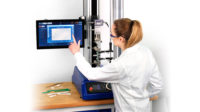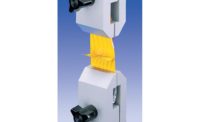Tensile Testing: A Gripping Story
Tensile testing is varied in purpose and industry specific. The manner of holding the test specimen and applying the axis of tensile force is what makes the application unique and enables quality assurance at almost any point in any product's lifecycle.

Tensile testing is just one, albeit important, method of physical property quality measurement implemented by a universal testing machine. An appropriately sized machine with enough load capacity and driven by modern software enables testing in any industry—when fitted with the correct grips.
All Images Source: Mecmesin, a PPT Group company
Being Pulled In All Directions
Physical testing is one essential step in the journey of any product from manufacturer to customer. In fact, it may occur at multiple stages from its design and development cycle through to production processes. For each business, the appropriate nature of the testing will vary. What defines being fit-for-purpose depends upon the role of the product in service and in some sectors that it has met industry regulations. In simple terms, functional performance is evaluated by the application of loading on the test piece and measuring the value at which something significant occurs.
This loading may be a force or a torque, applied to pull something apart, push it together or twist it in either direction. Tensile testing is the big hitter—using a universal testing machine (UTM) to apply an axial force to stretch or pull the specimen apart. The exact loading is facilitated by how the test piece is gripped, and how this axial force interacts with it. The fixturing accessories fitted to the test frame control this interaction and perform the precise loading required.
Grasping The Problem

What You Need to Know About Universal Testing
Moses Da Rocha, product and applications manager, PPT Group, explains the trends in universal testing.
Listen to more Quality podcasts.
Compression often holds things together, so securing the specimen is somewhat easier. Gripping objects that you are pulling apart securely and without slippage and in such a way as to not break them at the point of contact—which creates a stress raiser—is more of a challenge. In tensile testing, the fixturing involves an upper component attached to the frame’s moving ‘crosshead’ to not only hold the sample, but to perform the pull. The weight of the upper grip is a consideration as it will exert gravitational loading on the loadcell. A lower grip holds another part of the test specimen—in some cases the opposing end of a single component, in others another part of an assembly.
Two basic types of tensile test are broadly relevant; is the test specimen strong enough to resist breakage, or is it easy to use safely and efficiently?
Testing To Failure
For destructive tests, the equipment must ensure the test specimen breaks at the point of interest and not at the point(s) where it is being held.
Measurement of Ultimate Tensile Strength (UTS), toughness and break resistance are common objectives of destructive testing. These peak values are useful in the quality control (QC) environment (performed at point-of-manufacture) and in the R&D/NPD cycle for checking functional performance, particularly in safety-critical products which may be designed to support tensile loads in service.

Testing Ease-Of-Use
Testing that something won’t break is vital, but so is testing that it will perform as intended. Products which end up in the hands of the customer must work efficiently and ergonomically. This often means that low force is ideal as children or the elderly or infirm may be the intended users. A tolerance range of values is usually the target to pass; below which the product may operate unsafely or accidentally and above which the user may not be able to operate it at all. In addition, more information than a simple peak value will indicate further levels of quality perceived by the user.

Tactile attributes like feel, resistance and positive feedback can be quantified by graphical results delivered by the tensile test system’s software. Characteristics of the force curve—smooth, constant, rising, falling—can be correlated against benchmark quality objectives.
Testing For The Senses
We have seen some universally implemented tensile tests in the wide-reaching domain of engineered physical products that are built to last and easy to use. The UTM (in tensile-testing configuration) can also be flavored to perform important quality tests as a scientific instrument in other diverse sectors. Food technologists are constantly challenged to design products that do break down, and the manner in which this happens is sometimes the single most important quality-acceptance factor. The sensory parameter ‘mouthfeel’ qualifies how food feels in the mouth when bitten or chewed. Texture terms such as tender, crunchy, ripe and fresh correlate to mechanical properties of the food—which is essentially a material and can be tested in the same way. Many texture tests utilize fixtures to apply compression (biting compresses the food to crush or slice) but the tensile test method also has direct relevance, not just in mouthfeel, but also replicating how it behaves during processing, preparation and packaging.

Conclusions
The universal testing machine is just that—exactly what it says on the frame. With the addition of the right accessories, it can meet the quality assurance needs of almost any manufacturing industry, at all points in the product lifecycle. To do this, the frame just needs to hold the test specimen in the right manner—by means of the right grips and fixtures—and apply a tensile load. Or a compressive load, but that’s another story … one just as gripping.
Looking for a reprint of this article?
From high-res PDFs to custom plaques, order your copy today!





